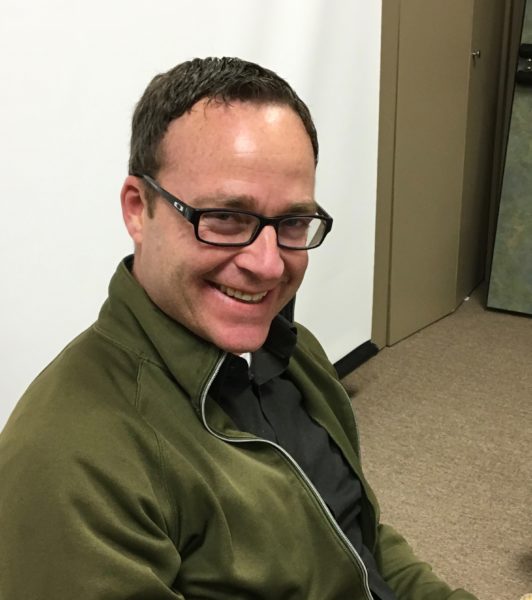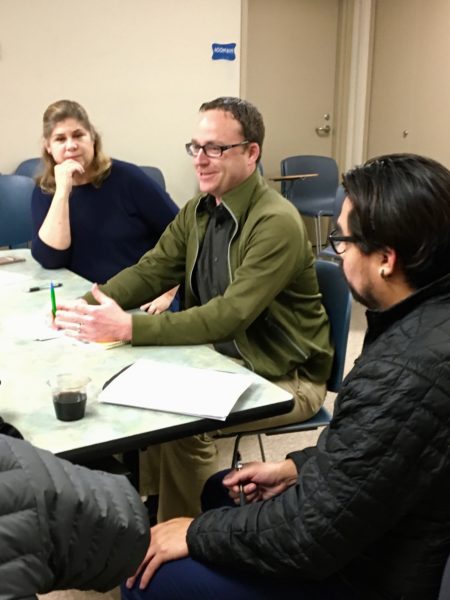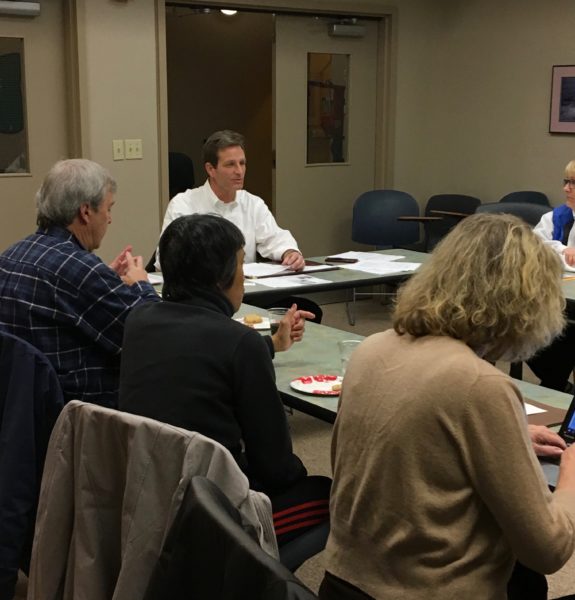
As leader of Seattle’s Vision Zero road safety initiative, Senior Traffic Planner Jim Curtin has a lot to say about how to make 24th Avenue in Montlake’s Business District safe for pedestrians, bicyclists, and vehicles. At the November MCC Board meeting, he and those present discussed “right sizing” as part of the SDOT plans for Aloha Street to SR520 –Phase 3 of the 23rd Ave Traffic Corridor Improvement Project.Curtin, MCC Board members, and concerned community members offered information, raised questions, and shared concerns. An hour passed quickly with upbeat, civil discussion about what may result when Phase 3 of the traffic safety project reaches Montlake.
“Right sizing,” Jim Curtin explained, is shaping streets not just to efficiently move vehicles and bicycles, but also:
* to save lives;
* reduce collisions;
* improve pedestrian mobility along and across streets;
* and raise awareness about the neighborhoods and businesses.
Right sizing can mean altering the number of lanes devoted to moving vehicles forward, and changing some lanes into turn lanes, or into transit only lanes. It can mean adding stop lights, reducing right turns on red lights, reducing speed limits, and/or installing traffic calming measures of various kinds. Choosing from all these methods of moving vehicle traffic while keeping everyone safe is just what professionals like Jim Curtin are tasked with doing on our behalf.
It’s fantastic, but no surprise, that these methods and outcomes mesh with the design being created through the M ontlake Business District Development Project. Jim Curtin was at the table representing SDOT when your Montlake Community Club planning team first met with Seattle Department of Neighborhoods representatives back in May. Even at that City Hall session, he was enthusiastically seconding the ideas the MCC planning team and consultants were expressing about our main street.
ontlake Business District Development Project. Jim Curtin was at the table representing SDOT when your Montlake Community Club planning team first met with Seattle Department of Neighborhoods representatives back in May. Even at that City Hall session, he was enthusiastically seconding the ideas the MCC planning team and consultants were expressing about our main street.
Jim Curtin has led a wide range of transportation projects for municipalities in Washington State over the past 15 years. He created SDOT’s Safe Routes to School program, and headed up the Aurora Traffic Safety Project that reduced serious and fatal collisions by 28 percent. Public education and engagement were critical to the success of those projects, says Jim, and they are standard elements in his Vision Zero approach. That’s welcome news here in Montlake, where we’ve often felt engaged in a token manner as City and State projects pushed through our neighborhood.
You can expect to be talking with Jim Curtin in a Montlake Community meeting in the not too distant future—as Phase three of the Corridor Project becomes a reality.
For more on Vision Zero in Seattle, see Josh Cohen’s Feb 12, 2015 article for Crosscut.

Simon says
I disagree. Drivers won’t get through the neighborhood any more quickly with the addition of general purpose lanes: the bottleneck isn’t usually a slow moving vehicle that is holding up traffic (which would be an argument for more lanes) but what happens at the intersections, particularly those from Roanoke north to Husky Stadium.
Reducing from 4 to 2 lanes w/ center lane wouldn’t add to the congestion: doing so would mean safer crossing for pedestrians and less of a very serious problem I’ve witnessed in the current configuration, namely that drivers finding themselves stuck behind someone making a left turn get frustrated and dart into the rightmost turn without carefully checking their blind spot — I just witnessed a hit-and-run by someone who did that last week. It’s safer to provide those turning left with a center lane where they can wait out of the flow of traffic. It’s also safer for cyclists, should they be on 24th, because cars passing them can often shift into that center lane to provide more clearance when passing.
As for keeping traffic out of the neighborhoods, I think that’s largely a matter of creating enough impediments to those who try that approach that they regret it. Not to say that’s an easy design problem, but I can imagine creating a maze that still allows our residents to get easily to and from their homes but prevents vehicles from paralleling 24th for more than a block or two before being diverted right back to an intersection w/ 24th to contend with. What is responsible for increasing numbers of cars barreling down my street (Roanoke east of 24th) is that there is no downside to the bypass other than a few more blocks of distance to travel, which drivers mitigate by driving faster.
(Really what I do not understand is why Seattle chooses to increase its population: doing so does not seem to be serving the interests of more than a few in the top 1%, yet everyone is bending over to accommodate. No reason not to create those jobs in some other city more in need of a boost in economy and that still has space on its streets.)
Paul Freiburger says
I disagree with Simon. Most evenings at Rush hour the traffic isn’t backed up only to Roanoke — it’s all of the way up the hill. Often to Boren or beyond. It’s not a left turn issue — it’s a capacity issue. Far and away it’s people trying to get through the lights to get to 520 or north of the cut, but going to three lanes instead of four will drastically reduce who gets through during each light cycle. Probably by a third or so. That will make traffic far worse. And the city has been systematically choking off traffic flow north-south along other arterials (Broadway) so there are no longer any alternatives. People aren’t going away, and it doesn’t work for most people to switch to alternative means of transportation. So they will either have to sit in traffic longer or seek out side streets. Even with barriers they will do that to jump ahead a couple of blocks rather than wait while only one or two cars get through each traffic light cycle. The congestion at the 520 interchange at rush hour is unlike the congestion at any other site the city has previously tried “traffic calming”. I haven’t seen any data on the Columbia City “traffic calming”, but I know from personal experience that it has drastically worsened the commute time through that area at rush hour. Doing something similar here would be a magnitude of order worse than there, and the reaction from drivers would likely be a magnitude of order worse as well.
Dolores says
I couldn’t agree more. Let those who proposed this change try to make a commute from south to North or North to South on 24th / Montlake Boulevard during commute hours which typically lasts from 3 p.m. true 7 p.m. . Try that daily for a week or two. Then think about how reducing Lanes will mitigateb, in any way, the congestion.
Paul Freiburger says
I also haven’t mentioned the psychological effects of lane reduction. Let’s say that magically the commute time on 24th were to stay the same at rush hour (it won’t of course). With reduced lane capacity the back-ups will still extend further up 24th. So even if the wait time was the same, when someone first encounters a traffic back-up at Interlaken versus McGraw, they are more likely to explore alternative side street approaches because it appears to them that they are further from getting through the congestion.
Simon says
These arguments hold in the short-term, but I do not believe they carry over to the long-term. With no end in sight for population growth, there is no end in sight to the demand for space to carry traffic; whatever accommodations are made to carry more traffic will saturate soon afterward.
Whether more lanes or fewer, traffic will eventually back up, so long as there are drivers willing to put up with the wait; when traffic backs up further, drivers will take alternate routes, and, those, too, will back up. So if we take the approach of maximizing capacity, all it buys us is a little time until more lanes or more routes are needed. We’ve seen this over and over again: add capacity and drivers use it, increasing the number of drivers until we’re right back where we were before EXCEPT there are now that many more of them because we’ve increased capacity.
Because I believe whatever capacity for traffic the neighborhood offers will become saturated, and saturated for an ever increasing proportion of the day, my view is that increasing capacity will result in attracting that much more traffic to the neighborhood. And that includes not just 24th, but also the alternative routes drivers will take whenever the available capacity along 24th saturates.
If we want to recover some of the positives for those living in Montlake, I believe we must instead do the opposite: reduce capacity, attract less traffic. If not reduce it, at least cap the traffic, limiting it to some fixed number of cars per hour through our neighborhood and then designing the neighborhood streets to be as safe as possible given that cap. The cap cannot be enforced directly, but it can be achieved implicitly by cutting down on the number of lanes on 24th and creating barriers to using side streets to bypass the inevitable congestion.
By reducing the number of lanes on 24th, we are prioritizing safety: fewer traffic lanes to cross for pedestrians, wider lanes that provide more safe passing area for and visibility of cyclists, and no opportunity for cars to dart from left to right lane to escape backups. In this way, we not only cap the capacity but we also do so in such a way that encourages other forms of transportation — bicycle and foot are more likely to be used, and, again, fewer cars overall.
Roanoker says
I whole-heartedly agree with Simon.
Traffic, and the speed at which that traffic attempts to avoid traffic from 24th AND Lake WA Blvd has increased ten-fold in recent years. I live on E. Roanoke with small children and have resorted to posting signs warning drivers that there are REALLY little kids in the area. It hasn’t helped. I’ve also noticed more drivers jumping the divider on Lake Washington Blvd (on a curve with a huge blindspot) and cutting through E. Roanoke. I almost got in a head-on when trying to take a right off E Roanoke St. on Lake WA Blvd. The driver saw me, but did it anyway.
The city needs to fix this issue–side traffic from *both* 24th and Lake Washington Blvd.
Paul Freiburger says
I absolutely agree with the comments above. The “right size” for 24th Ave is probably adding more lanes, not removing them. Everyone wins if traffic could get through our neighborhood more quickly. We want the traffic on arterials, not zipping down side streets or sitting there in gridlock spewing out exhaust. Bicyclists already have a safe route on 26th and 25th. That will become more dangerous if more traffic diverts off 24th to get around the gridlock. Any study that says reducing lanes won’t increase traffic on side streets is not a serious study. We have all lived it for many years.
Vivian says
Building more road capacity increases traffic, period. It’s called “induced demand” and it’s a well-known traffic engineering phenomenon (http://www.vox.com/2014/10/23/6994159/traffic-roads-induced-demand). Simon is right – the only thing that will work will be to block drivers from easily bypassing 24th by taking our neighborhood side streets, and there are ways to do it that do not inconvenience local residents (see, e.g. Berkeley, CA). It concerns me that there doesn’t seem to have been any discussion of doing this here in Montlake. Hopefully the MCC will raise this as a possibility in talks with the city.
Paul Freiburger says
By the way, I’m all for “inducing” traffic to leave the side streets and drive on 24th instead. That is the whole point of having an arterial. If we reduce capacity on 24th it will have the opposite effect — forcing traffic flow off of 24th on to side streets. I realize there is no way to add lanes to 24th, but we absolutely should not be considering reducing lanes. That is a big step in the wrong direction. I am in favor of your suggestion to do things to discourage drivers from taking side routes, but it should be done for the current bad situation, not only when reduced lanes on 24th makes things worse.
Dore says
Downsizing 24th Ave. is a joke. Traffic will be backed up for blocks and blocks, even more so than it is now. I can’t tell you how many times I’ve traveled north on 24th Ave., East and traffic is backed up to our very special business district. You need to do something about the congestion at the Montlake Bridge. Downsizing 24th is not the answer. Residents with driveways that back onto 24th Ave. East will never be able to get their cars out other driveways. For safety put in more designated crosswalks. To deal with speeding, put in photo enforced cameras.
mary davis says
The traffic from 23rd is already detouring down Boyer when it is slow. If you downsize lanes you will increase traffic onto the other streets.
The traffic at 5 corners, E Lynn and Boyer E intersection, is now often backed up 2 to 3 blocks waiting to go through the intersection elliptical round-about. Cars are idling in front of the house for hours. You will only make this worse by downsizing 23/ 24th.
I hope there is a plan for some neighborhood input, and not just an imposed plan by the consultants.
Denise Lishner says
Fine for the arterial but horrendous for our neighborhood streets- come take a look at the completely choked and gridlocked intersection of 26th and E Galer at 8:00 am or 5 PM (all day for that matter) and you will see where the traffic flow from reduced lanes on 23/24 is going!!!! Or don’t the needs of residents of Montlake matter?
Barbara Klube says
I agree